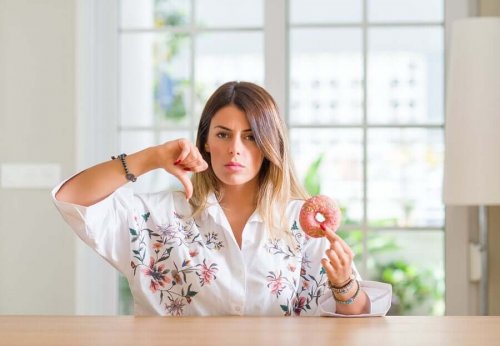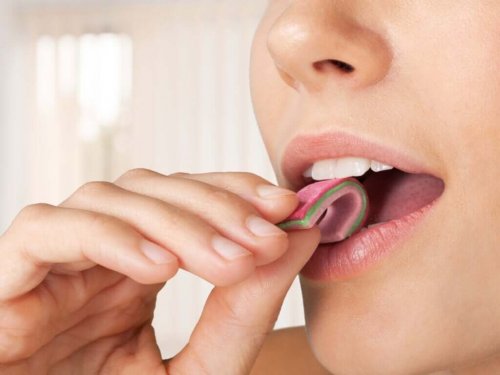A Diet for Sorbitol Intolerance

Have you ever felt gastrointestinal discomfort, gas, or diarrhea after eating some fruits, light products, or chewing gum? If so, you may suffer from sorbitol intolerance. Read on to learn how to follow a diet low in sorbitol.
What’s sorbitol?
Sorbitol is a sugar alcohol found naturally in red algae and the leaves and fruits of plants of the Rosaceae family, such as:
- Pears
- Apples
- Plums
- Quinces
- Peaches or apricots
Also, the food industry uses it widely as a sweetener, thickener, and humectant, as it’s able to sweeten by providing few calories.
Discover: Diet for Hereditary Fructose Intolerance and Fructose Malabsorption
What’s sorbitol intolerance?

People with sorbitol intolerance may have digestive problems such as pain, bloating, and gas.
Sorbitol intolerance is caused by a deficiency of a specific intestinal transporter. However, even in people without this deficit, a healthy person can only absorb a limited amount of this sugar, about 20-25 grams. Thus, if you exceed this amount, you may also suffer symptoms.
There are two types of sorbitol intolerance:
- Primary intolerance. This results from a deficit of the enzyme of the sorbitol transporter, GLUT5. Experts believe that there’s a genetic factor, and that it can develop throughout a person’s life.
- Secondary intolerance. Although there’s a genetic influence, it occurs following a bowel disease (gastroenteritis, inflammatory bowel disease, celiac disease, etc.) that damages the brush edge of the intestinal mucosa transiently or permanently.
Symptoms
Patients affected by this condition may have different symptoms that range from mild to severe. The most common symptoms include:
- Abdominal pain or cramping
- Swelling
- Distention or abdominal ballooning
- Gas
- Bowel sounds
- Diarrhea with gas
Foods that contain sorbitol
If you have sorbitol intolerance, you’ll have to follow a diet low in foods that contain sorbitol. Here are the foods that contain the most sorbitol:
Naturally (from highest to lowest amount)
- Fresh fruits. Pears, plums, peaches, apricots, apples, grapes, strawberries, raspberries, and blueberries.
- Fruit preserves. Apple juice, canned strawberries, redcurrant nectar, elderberry juice, blackcurrant nectar, and canned raspberries.
- Dried fruits. Prunes, dried peaches, dried apricots, dried apples, dried dates, and raisins.
Artificially

Gum, as well as light products and bakery products, contain sorbitol.
You can find it both in food products and cosmetic or pharmaceutical products as an additive. As an additive, sorbitol may appear as “sorbitol” (E420i) or “sorbitol syrup” (E420ii).
In food products, it’s present in jellies, jams, bakery and confectionery products, frozen products, chewing gum, light products, or “sugar-free” products. Thus, you must be careful with light products, as abusing them could trigger this kind of intolerance.
In cosmetic products, it’s present in toothpaste because it gives greater plasticity, a sweet taste, and, also, improved solubility. In the pharmaceutical industry, you can find it in topical creams. Likewise, you can find it in syrups.
This article may interest you: Find Out What the Most Common Food Allergies Are and Good Replacements
How to diagnose sorbitol intolerance
Currently, the hydrogen breath test is the best diagnostic test. The body’s inability to absorb sorbitol causes it to be fermented by colon bacteria, producing a large amount of free hydrogen. This hydrogen is what’s measured by exhaled air.
Before taking the test, the patient should have fasted for eight hours. In the 24 hours before the test, they shouldn’t eat fruits, vegetables, or legumes, as they slow down intestinal transit. In addition, it’s important to avoid taking laxatives or antibiotics in the days before the test.
If the result of the test is positive, the degree, as well as the symptoms that manifest, are evaluated in order to determine the diet the patient should follow.
Nutritional recommendations for sorbitol intolerance
- If you suspect an intolerance, then the first thing you should do is get tested. However, don’t change your diet on your own.
- Always check food labels to make sure they don’t contain sorbitol.
- If you suffer from severe sorbitol intolerance, then consult a specialist on the composition of any cosmetic product before using it.
- Limit the fruits that contain a lot of sorbitol.
- Be careful if you usually consume light products and chewing gum that contain sorbitol.
Are you worried that you might be suffering from this intolerance? If you’ve experienced its symptoms, then consult your doctor for an accurate diagnosis. In addition, if you’re diagnosed with this intolerance, make sure to follow these dietary recommendations.
All cited sources were thoroughly reviewed by our team to ensure their quality, reliability, currency, and validity. The bibliography of this article was considered reliable and of academic or scientific accuracy.
- Intolerancia a la fructosa-sorbitol. “Infogastrum” Asociación Española de Gastroenterología y las Sociedades Latinoamericanas de Gastroenterología.
- Intolerancia a la lactosa y fructosa-sorbitol. “GEMD” Grupo español de motilidad digestiva.
- Influencia del consumo de sorbitol en la microbiota intestinal de un modelo animal. Tesis Doctoral. Universidad Politécnia de Valencia. 2008
This text is provided for informational purposes only and does not replace consultation with a professional. If in doubt, consult your specialist.









